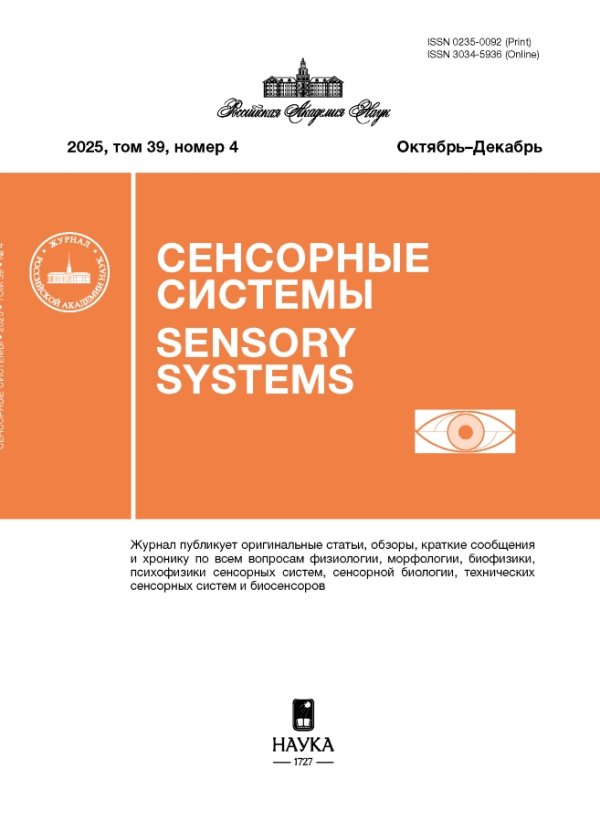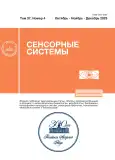Features of speech signal recognition in conditions of vocal competition with normal hearing and with hearing or speech disorders
- Authors: Balyakova A.A.1, Labutina O.V.1, Medvedev I.S.1, Pak S.P.1, Ogorodnikova E.A.1
-
Affiliations:
- Pavlov Institute of Physiology, Russian Academy of Sciences
- Issue: Vol 37, No 4 (2023)
- Pages: 342-347
- Section: ЭКСПЕРИМЕНТАЛЬНЫЕ ИССЛЕДОВАНИЯ
- URL: https://journals.rcsi.science/0235-0092/article/view/229415
- DOI: https://doi.org/10.31857/S0235009223040029
- EDN: https://elibrary.ru/QNREOL
- ID: 229415
Cite item
Full Text
Abstract
We studied the features of speech signals perception in conditions of vocal competition based on gender (male/female voice) in subjects of different ages and status of auditory and speech functions. Psychophysical measurements were carried out while simulating a “speech cocktail” situation by simultaneously pronounced different words by a male and female. The average fundamental voice frequency for the male speaker was 108 ± 5.92 Hz, for the female speaker – 185 ± 12.03 Hz. Both speakers were standard native speakers of the Russian language. Digital recordings of speech signals were equalized in intensity and compounded so that the total test stimulus was a synchronized mixture of words spoken by a male (M) and female (F) voice. Test speech signals were presented through headphones or through a speaker located in front of the auditor at a distance of 50 cm. The indicators of reaction time and the number of correct recognitions of words of the target speaker (M or F) were compared in 4 groups of subjects of different ages and hearing or speech status: adult subjects with normal hearing and speech (n = 35) and with hearing impaired (n = 26); schoolchildren with normotypical development (n = 26) and with speech disorders (n = 25). The results indicated a falling in the ability to segrerate target speech streams under conditions of vocal competition in the subjects with hearing and speech dysfunctions included in the comparative study. Differences in the perception of male and female voices in subjects with hearing loss and with speech problems were obtained. This result may have a biological and social basis. The data have practical significance for the development of a system of auditory and speech training and modern hearing aid technologies.
About the authors
A. A. Balyakova
Pavlov Institute of Physiology, Russian Academy of Sciences
Email: ogorodnikovaea@infran.ru
Russia,
199034, St. Petersburg, Makarov emb., 6
O. V. Labutina
Pavlov Institute of Physiology, Russian Academy of Sciences
Email: ogorodnikovaea@infran.ru
Russia,
199034, St. Petersburg, Makarov emb., 6
I. S. Medvedev
Pavlov Institute of Physiology, Russian Academy of Sciences
Email: ogorodnikovaea@infran.ru
Russia,
199034, St. Petersburg, Makarov emb., 6
S. P. Pak
Pavlov Institute of Physiology, Russian Academy of Sciences
Email: ogorodnikovaea@infran.ru
Russia,
199034, St. Petersburg, Makarov emb., 6
E. A. Ogorodnikova
Pavlov Institute of Physiology, Russian Academy of Sciences
Author for correspondence.
Email: ogorodnikovaea@infran.ru
Russia,
199034, St. Petersburg, Makarov emb., 6
References
- Boboshko M.J., Garbaruk E.S., Zhilinskaya E.V., Salakhbekov M.A. Tsentral’nye slukhovye rasstroistva (obzor literatury) [Central auditory processing disorders (literature review)] Russian otorhinolaryngology. 2014. V. 5. P. 87 (in Russian).
- Gaykova Yu.S., Lyakso E.E. Individual’nyy vklad kharakteristik materinskoy rechi v rechevoye razvitiye rebenka pervogo goda zhizni. [Individual contribution of maternal speech characteristics to the speech development of a child in the first year of life] Bulletin of St. Petersburg University. Series 3: Biology. 2011. № 3. P. 66–74 (in Russian).
- Grinenko S.V. Gendernaya assimetriya v obrazovanii. [Gender asymmetry in education] Modern scientific research and innovation. 2014. № 12 (3). URL: http://web.snauka.ru/issues/2014/12/41818 (in Russian).
- Yerkudov V.O., Ogorodnikova E.A., Pugovkin A.P., Ser-geyev I.V., Slyaptsova T.N., Kundrat Ye.O., Lupanova P.A., Pakhomova M.A., Denisenko M.D., Bala-shov A.L. Vydeleniye golosa tselevogo diktora v usloviyakh rechevoy konkurentsii u shkol’nikov s razlichnym psikhoemotsional’nym statusom. [Selection of the target speaker’s voice in conditions of speech competition among schoolchildren with different psycho-emotional status]. Pediatrician. 2019. V. 10. № 4. P. 51–59. https://doi.org/10.17816/PED10451 (in Russian).
- Koroleva I.V. Osnovy audiologii i slukhoprotezirovaniya. [Fundamentals of audiology and hearing aid]. SPb.: KARO, 2022. 448 p. (in Russian).
- Koroleva I.V., Ogorodnikova E.A., Pak S.P., Levin S.V., Baliakova A.A., Shaporova A.V. Metodicheskiye podkhody k otsenke dinamiki razvitiya protsessov slukhorechevogo vospriyatiya u detey s kokhlearnymi implantami. [Methodological approaches to assessing the dynamics of the development of hearing and speech perception processes in children with cochlear implants] Russian Otorhinolaryngology. 2013. № 3. P. 75–85. (in Russian).
- Koroleva I.V., Ogorodnikova E.A., Pak S.P., Levin S.V. Znacheniye tsentral’nykh mekhanizmov slukha v vosstanovlenii vospriyatiya rechi u glukhikh patsiyentov posle kokhlearnoy implantatsii. [The importance of central hearing mechanisms in the restoration of speech perception in deaf patients after cochlear implantation] Special education. 2017. № 3. P. 100. (in Russian).
- Ogorodnikova E.A., Balyakova A.A., Zhilinskaya E.V., Okhareva N.G., Pak S.P., Boboshko M.Yu. Slukhovaya trenirovka kak metod reabilitatsii patsiyentov s narusheniyami slukha i rechi [Auditory training as a method of rehabilitation of patients with hearing and speech impairments] Folia Otorhinolaryngologiae et Pathologiae Respiratoriae. 2017. V. 23. № 1. P. 33. (in Russian).
- Ogorodnikova E.A., Labutina O.V., Pak S.P. Imitatsiya slozhnoy akusticheskoy stseny pri stimulyatsii cherez golovnyye telephony [Simulation of a complex acoustic scene when stimulated through headphones]. Bulletin of psychophysiology. 2022. № 2. P. 140–146. https://doi.org/10.34985/o0640-6924-4290-f (in Russian).
- Ogorodnikova E.A., Stolyarova E.I., Balyakova A.A. Osobennosti slukhorechevoy segmentatsii u detey shkol’nogo vozrasta s normal’nym slukhom i narusheniyami slukha i rechi [Features of auditory-speech segmentation in school-age children with normal hearing and hearing and speech impairments] Sensory systems. 2012. V. 26. № 1. P. 20–31. (in Russian).
- Andreeva I.G. Spatial selectivity of hearing in speech recognition in speech-shaped noise environment. Hum Physiol. 2018. V. 44 (2). P. 226–236. https://doi.org/10.1134/S0362119718020020
- Bregman A.S. Auditory scene analysis: the perceptual organization of sound. Cambridge: MIT Press. 1990.
- Bronkhorst A.W. The cocktail-party problem revisited: Early processing and selection of multi-talker speech. Attention, Perception & Psychophysics. 2015. V. 77(5). P. 1465–1487. https://doi.org/10.3758/s13414-015-0882-9
- Cherry E.C. Some experiments on the recognition of speech, with one and with two ears. J. Acoust. Soc. Am. 1953. V. 25. № 5. P. 975.
- Efendi D., Caswini N., Rustina Y., Iskandar A.D. Combination of mother therapeutic touch (MTT) and maternal voice stimulus (MVS) therapies stabilize sleep and physiological function in preterm infants receiving minor invasive procedures. Journal of Neonatal Nursing. 2018. № 6 (24). P. 318–324. https://doi.org/10.1016/j.jnn.2018.08.001
- Fogerty D., Ahlstrom J.B., Bologna W.J., Dubno J.R. Sentence intelligibility during segmental interruption and masking by speech-modulated noise: Effects of age and hearing loss. J Acoust Soc Am. 2015. 137 (6): 3487–501. https://doi.org/10.1121/1.4921603
- Gutschalk A., Dykstra A.R. Functional imaging of auditory scene analysis. Hear. Res. 2014. V. 307. P. 98.
- Kalikow D.N., Stevens K.N., Elliott L.L. Development of a test of speech intelligibility in noise using sentence materials with controlled word predictability. J Acoust Soc Am. 1977. 61 (5): 1337–51. https://doi.org/10.1121/1.381436. PMID: 881487
- Moore B.C.J. An Introduction to the Psychology of Hearing. Leiden. Brill. 2012. 442 p.
- Musiek F.E., Chermak G.D. Handbook of central auditory processing disorder. San Diego. Plural Publishing. 2014. V. 1. Auditory neuroscience and diagnosis. 768 p.
- Popper A.N., Fay R.R. (Eds). Perspectives on auditory research. Springer handbook of auditory research. 2014. 680 p.
- Shamma S.A., Elhilali M., Micheyl C. Temporal coherence and attention in auditory scene analysis. Trends Neurosci. 2011. V. 34. P. 114.
Supplementary files











